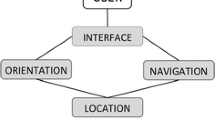Abstract
In recent years, there has been an escalation of orientation and wayfinding technologies and systems for visually impaired people. These technological advancements, however, have not been matched by a suitable investigation of human-computer interaction (e.g. designing navigation aids for people who form different cognitive maps for navigation). The aim of this study is to investigate whether a group of sighted participants and a group of visually impaired participants experience a difference in mental and physical demands when given two different sets of verbal instructions directing them to four landmarks. The content of the first set of instructions was proportioned to route descriptions derived from sighted people, and the second set proportioned to descriptions derived from visually impaired people. The objective assessment involved measuring the time taken by participants to reach landmarks and the number of deviations that occurred. A NASA–Task Load Index questionnaire provided an indication of participants subjective perception of workload. The results revealed that instructions formed from visually impaired people resulted in a lower weighted workload score, less minor deviations, and quicker times for visually impaired participants. In contrast, these instructions were found to cause a higher weighted workload score for sighted participants. The results are discussed in relation to the issue of personalisation of mobile context-aware systems for visually impaired people.








Similar content being viewed by others
References
Balliwalla, Low Vision—Assessment and Aids, Bombay Hospital Journal http://www.bhj.org/journal/2002_4403_jul/md_397.htm, 2002
Maeda Y, Tano E, Makino H, Konishi T, Ishii I (2002) Evaluation of a GPS-based guidance system for visually impaired pedestrians. In: Technology and persons with disabilities conference 2002. March 18–23, Los Angeles, California, USA
May M (2000) Accessible GPS navigation and digital map information for blind consumers. ICWC
Strothotte T, Fritz S, Michel R, Raab A, Petrie H, Johnson V, Reichert L, Schalt A (1996) Development of dialogue systems for the mobility aid for blind people: initial design and usability testing. ASSETS ’96, Vancouver, British Columbia, Canada, pp 139–144
Golledge RG, Klatzky RL, Loomis JM, Speigle J, Tietz J (1998) A geographical information system for a GPS based personal guidance system. Int J Geograph Inform Sci 12(7):727–749
Franklin N (1995) Language as a means of constructing and conveying cognitive maps. In: Portugali J (ed) The construction of cognitive maps. Kluwer, Dordrecht pp 275–295
Pitt IJ, Edwards ADN (1996) Improving the usability of speech-based interfaces for blind users. 2nd annual ACM conference on assistive technologies. Vancouver, Canada, pp 124–130
Ross DA, Blasch BB (2000) Evaluation of orientation interfaces for wearable computers. ISWC’00
Sabelman EE, Burgar CG, Curtis GE, Goodrich G, Jaffe DL, Mckinley JL, Van Der Loos M, Apple LG (1994) Personal navigation and wayfinding for individuals with a range of disabilities, Project report: Device development and evaluation. http://guide.stanford.edu/Publications/dev3.html
Dodson AH, Moore T, Moon GV (1999) A navigation system for the blind Pedestrian, GNSS 99. Genoa, Italy, pp 513–518
Helal AS, Moore SE, Ramachandran B (2001) Drishti: An integrated navigation system for visually impaired and disabled. In: 5th international symposium on wearable computers, Zurich, Switzerland
Petrie H (1995) User requirements for a GPS-based travel aid for blind people. In: Gill JM, Petrie H (eds) Orientation and navigation systems for blind persons. 1–2 February, RNIB, UK
Kay L (1980) Air sonar with acoustical display of spatial information. In: Busnel RG, Fish JF (eds) Animal sonar system. Plenum, New York, pp 769–816
Bradyn JA (1985) A review of mobility aids and means of assessment. In: Warren DH, Strelow ER (eds) Electronic spatial sensing for the blind. Martinus Nijhoff, pp 13–27
Fruchterman J (1995) Archenstone’s orientation tools: Atlas speaks and strider. In: Gill JM, Petrie H (eds) Orientation and navigation systems for blind persons. Hatfield, February 1995. RNIB, UK, pp 1–2
Kemmerling M, Schliepkorte H (1998) An orientation and information system for blind people based on RF-speech-beacons. TIDE, Helsinki
Ertan S, Lee C, Willets A, Tan H, Pentland A (1998) A wearable haptic navigation guidance system. 2nd international symposium on wearable computer, Pittsburgh, PA, pp 164–165
Golding AR, Lesh N (1999) Indoor navigation using a diverse set of cheap, wearable sensors. In: third international symposium on wearable computers. San Francisco, CA, pp 29–36
Long S, Aust D, Abowd GD, Atkeson C (1996) Cyberguide: prototyping context-aware mobile applications. In CHI ’96 conference companion, pp 293–294
Loomis JM, Golledge RG, Klatzky RL (2001) GPS-Based navigation system for the visually impaired. In: Barfield W, Caudell T (eds) Fundamentals of wearable computers and augmented reality. Lawrence Erbaum Associates, Mahwah NJ, pp 429–446
Downs RM, Stea D (1997) Cognitive maps and spatial behaviour: process and products. In: Downs RM, Stea D (eds) Image and Environment. Aldine, Chicago, pp 8–26
Jonsson E (2002) Inner navigation: why we get lost and how we find our way. Scribner, New York, pp 27–126
Kitchin RM, Blades M, Golledge RG (1997b) Understanding spatial concepts at the geographic scale without the use of vision. Progr Human Geography 21(2):225–242
Kitchen RM, Jacobson D (1997) Techniques to collect and analyze the cognitive map knowledge of people with visual impairments or blindness: Issues of validity. J Visual Impair Blind 360–376
Zetie C. Market overview: The emerging context-aware software market, unwired express website, http://www.unwiredexpress.com
Dey AK, Abowd GD (2000) Towards a better understanding of context and context-awareness. In: CHI 2000 Workshop on The What, Who, Where, When, and How of Context-Awareness, The Hague, Netherlands
Bradley NA, Dunlop MD (2002a) Investigating context-aware clues to assist navigation for visually impaired people. In: Workshop on Building Bridges: Interdisciplinary Context-Sensitive Computing, University of Glasgow, Scotland, 9th September 2002, pp 5–10
Pascoe J (1998) Adding generic contextual capabilities to wearable computers. In: Proceedings of 2nd international symposium on wearable computers, pp 92–99
Kitchin RM, Blades M, Golledge RG (1997a) Relations between psychology and geography. Environ Behavior 29(4):554–573
LaGrow S, Weessies M (1994) Orientation and mobility: techniques for independence. The Dunmore Press Limited, New Zealand, p 9
Bradley NA, Dunlop MD (2002) Understanding contextual interactions to design navigational context-aware applications. Mobile HCI, 18–20th September 2002, Pisa, pp 349–354
Hart S, Staveland L (1988) Development of NASA-TLX (Task Load Index): results of empirical and theoretical research. In: Hancock P, Meshkati N (eds) Human mental workload. North Holland BV, pp 139–183
Bradley NA, Dunlop MD (2003) Towards a multidisciplinary user-centric design framework for context-aware applications. 1st UK-UbiNet Workshop, Imperial College London, 25th–26th September 2003
Dey AK, Salber D, Abowd GD (2001) A conceptual framework and a toolkit for supporting the rapid prototyping of context-aware applications. Human Comput Interact J 16(2-4):97–166
Schilit B, Adams N, Want R (1994) Context-aware computing applications. In: First international workshop on mobile computing systems and applications pp 85–90
Schilit B, Theimer M (1994) Disseminating active map information to mobile hosts. IEEE Network 8(5):22–32
Dourish P (2001) Seeking a foundation for context-aware computing. J Human-Comput Interact 16:2–4
Acknowledgements
This work is partly supported by the EU funded project GLOSS (Global Smart Spaces). We would like to thank the Glasgow and West of Scotland Society for the Blind for assisting with the study, and the participants who kindly took part.
Author information
Authors and Affiliations
Corresponding author
Rights and permissions
About this article
Cite this article
Bradley, N.A., Dunlop, M.D. An Experimental Investigation into Wayfinding Directions for Visually Impaired People. Pers Ubiquit Comput 9, 395–403 (2005). https://doi.org/10.1007/s00779-005-0350-y
Published:
Issue Date:
DOI: https://doi.org/10.1007/s00779-005-0350-y




